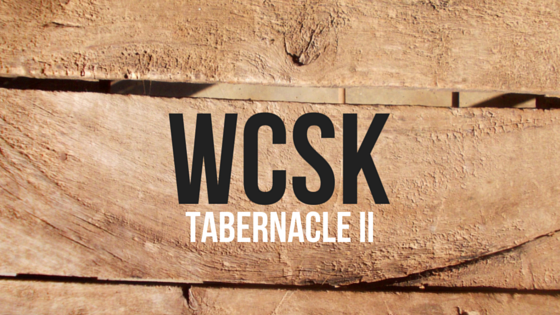The Tabernacle Proper
The walls of the tabernacle proper and its pillars were made of two distinct materials: acacia wood and gold. The gold was pure and refined and the wood was a very special type: acacia or shittim, an incorruptible form of desert wood. Gold represents deity. Acacia trees grew in the desert only under duress and extreme circumstances. The wood represents Christ’s humanity, “like a root out of parched ground,”[1] highlighting the virgin birth. The wood was overlaid with gold, yielding a uniform piece made up of two elements, which represents the perfect unison of the human and divine natures inherent in Jesus.
Thus, the tabernacle was composed of 48 wooden boards that were overlaid with pure gold. Two projections on the underside of each board fit into the pure silver sockets underneath. Additionally, the boards were held together by five horizontal bars of gold-covered wood. Moreover, ropes were passed tightly over the roof of the tabernacle and secured into the ground with pins on each side. These indestructible ropes represent the love of Jesus: “I led them with cords of a man, with bonds of love.”[2] It becomes clear that the tabernacle was very sturdy and was the most secure place in the entire Israelite camp. Hence, being in the tabernacle, or being in Christ made a person entirely safe and secure (c.f. Psalm 91:1-9).
Furthermore, the NASB translates Exodus 27:19 as “All the utensils of the tabernacle used in all its service, and all its pegs, and all the pegs of the court, shall be of bronze” (italics mine). It translates Exodus 35:18 as “the pegs of the tabernacle and the pegs of the court and their cords” (italics mine). The root of the word pegs in Hebrew, yated, can also mean nail, pin, or stake. All the pins were made of brass and were, therefore, resistant to rust and corrosion. They were buried in the ground (death) but a portion still rose above the ground (resurrection) in order to secure the ropes that anchored both the fence and the tabernacle. Hence, in Christ, we are held secure by the durable nail that is Christ: “I will drive him like a peg in a firm place, and he will become a throne of glory to his father’s house. So they will hang on him all the glory of his father’s house, offspring and issue, all the least of vessels, from bowls to all the jars.”[3] Of course, the pegs being fastened into the ground also points to Christ’s body being nailed to the Cross.
The roof.[4] The roof of the tabernacle was composed of four layers. We shall move from the innermost layer of the building (and therefore what could be seen while in the tabernacle) to the outermost layer (and therefore what could only be seen from the outside).
The first roof layer consisted of fine linen, representing perfect righteousness, embroidered with the colors of white, blue, purple, and scarlet. Cherubim, or guardians of God’s holiness, with outstretched wings were embroidered into the fabric of the ceiling and therefore “watched over” the priests as they performed duties in the tabernacle.
The second roof layer, placed over the linen, was made of goat’s hair. This represented Christ’s sin offering, as a goat was a clean animal that was offered on the Day of Atonement (in the Old Testament) as a sacrifice. One goat was sacrificed (to temporarily atone for sins) and one goat was led into the wilderness (to remove the guilt of sin away from the midst of the people).[5] The fact that linen rested under the goat’s hair symbolizes that our righteousness in Christ is contingent upon His atoning sacrifice.[6]
The third roof layer consisted of ram’s skins that were dyed red. This speaks directly to the substitutionary atonement for sins by the blood of Jesus on the Cross. Figuratively, then, the one who is in the tabernacle is therefore under and totally covered by Jesus’s atoning blood sacrifice. The use of the ram looks back to Abraham, who was provided a ram by God to offer as a sacrifice in the place of his son, Isaac.[7] In actuality, Isaac could not have been an acceptable sacrifice because he was a sinner. Something else needed to atone for sins. Hence, the ram is a symbol for the substitution of God for the sinner.
The fourth and outermost roof layer was the covering of porpoise skins. This represented the…
Drs. C. H. S. and C. H. E. Sadaphal
For Further Study
DeHann, M. R., The Tabernacle (Grand Rapids, MI: Zondervan, 1955).
Rose Publishing, Rose Guide to the Tabernacle with Clear Plastic Overlays and Reproducible Charts (Torrance, CA: Rose Publishing, 2008).
[1] Isaiah 53:2
[2] Hosea 11:4
[3] Isaiah 22:23-24
[4] Exodus 26:1-14
[5] Leviticus 16:15-22
[6] Isaiah 53:6; John 10:18; II Corinthians 5:21; Hebrews 9:28
[7] Genesis 22:1-14
[8] Deuteronomy 29:5; Nehemiah 9:21
[9] Exodus 25:23-30
[10] John 6:35, 48, 51
[11] Job 16:12
[12] Matthew 6:9-13
[13] Exodus 25:31-37; c.f. Isaiah 11:1-3; Ephesians 4:22-24; Revelation 5:6
[14] I Corinthians 2:14
[15] Isaiah 61:1; Acts 10:38
[16] Luke 3:21
[17] DeHann, M.R., The Tabernacle (Grand Rapids, MI: Zondervan, 1955), 101.
[18] Luke 19:10
[19] I Corinthians 11:1; Ephesians 5:1-2
[20] John 9:5
[21] Exodus 30:1-9
[22] For example, see Luke 10:38-42
[23] Psalm 141:2
[24] Ephesians 5:1-2
[25] Leviticus 10
[26] I Corinthians 15:3-4
[27] Hebrews 7:25
[28] Exodus 26:31-33
[29] Hebrews 10:20
[30] John 19:30
[31] Matthew 27:50-51; Mark 15:37-38; Luke 23:45
[32] Exodus 25:10-16
[33] Exodus 12:13
[34] I Samuel 6:19
[35] John 6:51
[36] Exodus 25:17-22
[37] I John 1:7
[38] Exodus 25:11
[39] I Kings 17:1-6
[40] Philippians 2:1-8
[41] Matthew 11:30
[42] Mark 2:17; Luke 5:32; I Timothy 1:15

